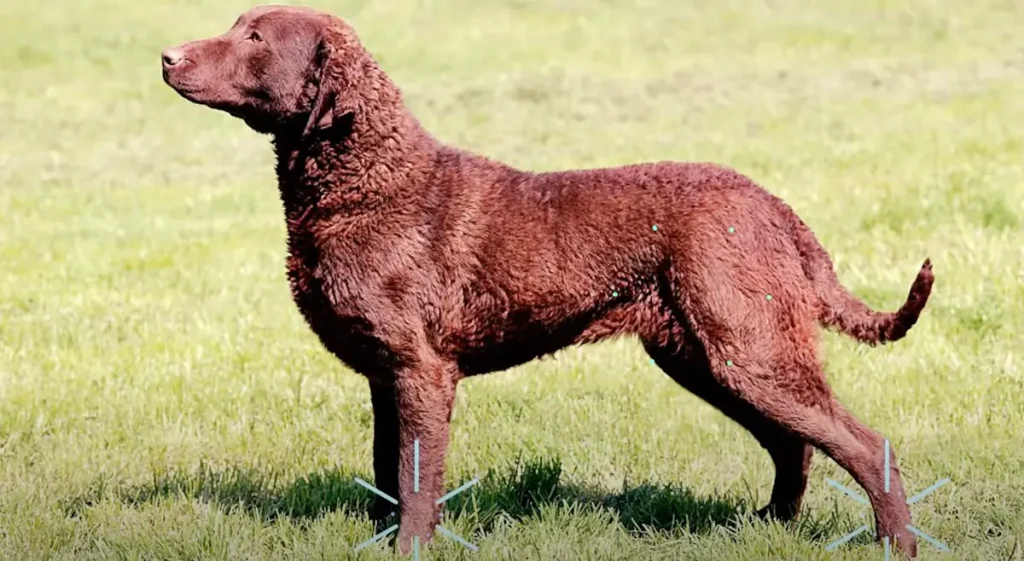Like Odysseus returning from the Trojan War, the Chesapeake Bay Retriever’s journey from the American Mid-Atlantic to its status as a prized waterfowl hunter is a tale of resilience and skill.
Considering the dense, waterproof coat that bristles along the back of a ‘Chessie’, it’s clear you’re looking at a breed built to withstand the chill of the Chesapeake Bay’s icy waters.
Their acute intelligence and keen sense of smell have earned them a reputation as one of the most proficient retrievers, especially under challenging conditions.
Yet, while their physical attributes are impressive, their courage and determination in the face of a relentless wave or a hidden marsh truly sets them apart.
If you’re drawn to the allure of a dog whose loyalty is as steadfast as their retrieve, you may find yourself wondering: what else lies beneath the surface of this tenacious breed?
- Noise Level
- Energy
- Sociability
- Trainability
- Care
- Health
Overall
Summary
The Chesapeake Bay Retriever is characterized by moderate noise levels and high energy, making them suitable for active lifestyles. They exhibit sociable behavior and are relatively trainable, requiring moderate care and generally maintaining good health.
Chesapeake Bay Retriever: Traits, Temperament, and Care Guide
Among the Chesapeake Bay Retriever’s distinctive traits, its dual aptitude for conformation and field championships stands out. This reflects a versatile skill set as robust in structured competition as in the unpredictable outdoors.
Your training approach should leverage positive reinforcement, fostering the breed’s independent thinking crucial for waterfowl hunting. Their oily double coat equips them well for the task, enhancing their innate abilities as a hunting dog.
Exploring the Characteristics of the Chesapeake Bay Retriever
Delving into the characteristics of the Chesapeake Bay Retriever, you’ll find that their unique dual championship in conformation and field trials is a testament to their versatile capabilities.
| Trait | Benefit | Relevance to Hunting |
|---|---|---|
| Independence | Thinks for themselves; less guidance needed | Essential for field |
| Responsive to Training | Positive reinforcement builds strong skills | Key for waterfowlers |
| Suited For Cold | Excels in harsh conditions | Ideal for American waterfowling |
| Coat Camouflage | Blends with environment; stealthy approach | Advantage for hunting |
Chesapeake Bay Retriever: A Comprehensive Profile and Guide
As you explore the Chesapeake Bay Retriever’s unique profile, it’s crucial to note their exclusive status as dual champions in show and field.
Their independent thinking capabilities necessitate a training approach rooted in positive reinforcement tailored to leverage their natural hunting prowess.
When handling a Chesapeake, you must adopt a firm yet kind leadership style to harness its strengths in cold climates and challenging terrains.
Everything You Need to Know
The Chesapeake Bay Retriever offers a unique blend of independence, intelligence, and ruggedness for the dedicated enthusiast seeking a versatile hunting partner. This breed requires a nuanced approach to training that respects their capacity for understanding complex commands.
- Dual championship prowess in field and conformation
- Independence requiring ‘why’ in training
- Positive reinforcement and strategic electronic collar use
- Commanding presence for strong loyalty
- Excellent cold weather and rough terrain performance
Embrace the Chesapeake Bay Retriever’s waterfowl hunting skills for great hunting success.
Discovering the Temperament
When exploring the temperament of the Chesapeake Bay Retriever, it’s essential to recognize that their independent nature and sharp intellect shape a personality well-suited for both companionship and specialized tasks like hunting.
As potential family dogs or hunting companions, they require training methods that hinge on positive reinforcement.
Their guard dog instincts affirm their loyalty, ensuring they’re reliable both in the field and at home.

Chesapeake Bay Retriever: Is It a Good Fit for Families?
When determining whether a Chesapeake Bay Retriever is suitable for your family, you must consider its need for daily mental and physical engagement.
Their protective nature and trainability can be assets in a household, provided you’re committed to consistent obedience training.
Remember that their thick, waterproof coat and predisposition to hip dysplasia necessitate regular grooming and health monitoring.
Assessing Chesapeake Bay Retriever’s Compatibility with Families and Kids
Assessing the Chesapeake Bay Retriever’s compatibility with families and children reveals that this breed’s protective nature and affinity for play make it a suitable companion for active households.
- Protective of family members
- Requires active engagement and play
- Intelligent and trainable with time and patience
Affiliated with the American Chesapeake Club, Chesapeake Bay Retrievers are recognized as a breed devoted to their families and eager to please. They can live long lives, making them lasting family members.
It’s a good idea to consider a Chesapeake Bay Retriever if you’re seeking a devoted and playful dog breed.
Chesapeake Adaptability Quirks
Chesapeake Bay Retrievers often display a notable degree of independence. This means they require an adaptive training approach that acknowledges their need to understand the reasons behind given commands.
Your Chesapeake’s adaptability quirks emerge from its lineage. It comes from stoic Newfoundland puppies, which were necessary for mastering icy waters. This lineage has influenced its behavior and instincts.
It is important to have a technical and benevolent handler to optimize your Chesapeake’s waterfowl hunting skills. This handler should respect your dog’s thick outer coat and intelligence. By understanding and working with these characteristics, you can help your Chesapeake excel in its hunting abilities.
When training and working with a Chesapeake Bay Retriever, it is important to seek partnership rather than coercion. These dogs are loyal, and by building a strong bond based on trust and respect, you can harness their loyalty and achieve great results.
Chessie Retrieval Techniques
It would be best to harness the Chesapeake’s innate retrieval prowess through structured training regimens.
Their ability to mark and recall the location of downed game requires you to reinforce these skills with repetitive, scenario-based exercises.
Tailoring your techniques to their unique coat properties and stamina will enhance their natural efficiency in waterfowl retrieval.
Effective Training Strategies
To effectively train a Chesapeake Bay Retriever, it’s essential to implement a tailored strategy that leverages their instincts and complements their personality.
| Technique | Application | Benefit |
|---|---|---|
| Positive Reinforcement | Hunt Test Preparation | Enhances Problem-Solving Skills |
| Partnership Approach | Waterfowl Hunting | Strengthens Gun Dog Abilities |
| Electronic Collar Use | Search and Rescue | Improves Precision and Timing |
Exercise and Grooming Needs
Maintaining the health and happiness of a Chesapeake Bay Retriever requires a commitment to regular, vigorous exercise, such as daily retrieving games or swimming sessions, and attentive grooming to uphold the integrity of their dense, water-repellent coat.
As a large dog, they’re prone to joint issues like hip dysplasia, making consistent exercise crucial.
Meticulous grooming, especially in icy conditions, combats seasonal shedding, sustaining their coat’s resilience.

Health Considerations for Chesapeake Bay Retriever
As you consider a Chesapeake Bay Retriever, it’s imperative to understand their susceptibility to hip dysplasia, a genetic condition affecting the hip joint that can lead to arthritis or lameness.
Meticulous grooming practices are necessary to safeguard their dense coat from matting, which can result in skin infections if neglected.
Common Health Issues and Lifespan
Chesapeake Bay Retrievers, affectionately known as ‘Chessies,’ typically enjoy a healthy lifespan of 10-13 years. However, they are predisposed to certain joint issues such as hip dysplasia, necessitating vigilant health monitoring.
As a responsible Chesapeake Bay Retriever owner, you must prioritize regular vet check-ups to identify common health issues early. This will help ensure that any potential problems are addressed promptly and effectively.
Proper grooming is also essential for your Chessie’s overall well-being. Regular brushing and nail trimming will keep their coat looking great and help prevent matting and other skin issues.
A balanced diet is another crucial aspect of caring for your Chesapeake Bay Retriever. Providing them with high-quality dog food that meets their specific nutritional needs is essential for maintaining their overall health and vitality.
Understanding your individual dog’s needs is also important. Each Chessie is unique, and what works for one may not work for another. Please pay attention to their behavior, energy levels, and any changes in appetite or demeanor, as these can indicate underlying health issues.
Is Chesapeake Bay Retriever the Right Pet for You?
If you’re considering a Chesapeake Bay Retriever as your next pet, evaluating whether their independent nature and intense loyalty align with your lifestyle and training capabilities is crucial.
As one of the best dogs for adept handlers, Chesapeakes thrive with positive reinforcement and a clear understanding of commands. Prospective Chesapeake Bay Retriever owners must be commanding yet benevolent when training this skilled and loyal breed.
Conclusion
In summary, the Chesapeake Bay Retriever is a breed epitomizing rugged versatility. Rigorous analysis confirms their superior retrieval instincts and resilience in adverse conditions. With their dense coat and webbed feet, they thrive in aquatic environments.
However, potential owners must commit to meeting their exercise and grooming needs. Their protective nature and loyalty make them exceptional family members, which also necessitates responsible training. Assessing your lifestyle is crucial when considering a Chessie as a lifelong companion.
Frequently Asked Questions
Are Chesapeake Bay Retrievers Good Duck Hunting Dogs?
Chesapeake Bay Retrievers excel in duck retrieving, their strong swimmer skills and cold tolerance stand out. Their tenacious demeanor, obedience, and natural camouflage make them top-notch hunting companions.
Are Chesapeake Bay Retrievers Shedders?
Yes, your Chesapeake Bay Retriever’s lush coat does gracefully release fur. Shedding patterns peak seasonally, so grooming tips are vital. For allergy considerations, consistent coat care and double coat maintenance can mitigate discomfort.
Why Not to Get a Chesapeake Bay Retriever?
You might reconsider a Chesapeake if high maintenance, strong-willed nature, ample space requirements, rigorous exercise demands, and training challenges deter you. They’re not hypoallergenic, demanding commitment to fit your desire for belonging.
What Are Some Interesting Facts About the Chesapeake Bay Retriever?
Chesapeake Bay Retrievers boast unique coat coloration, webbed paws for swimming, and historical origins linked to waterfowl hunting. They’re loyal companions with distinct personality traits and a lifespan expectancy of 10-13 years.
